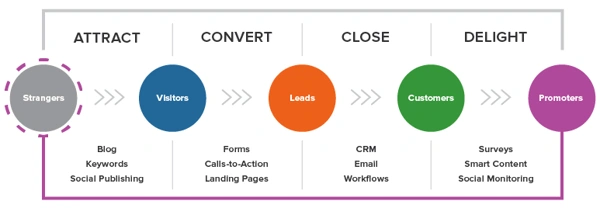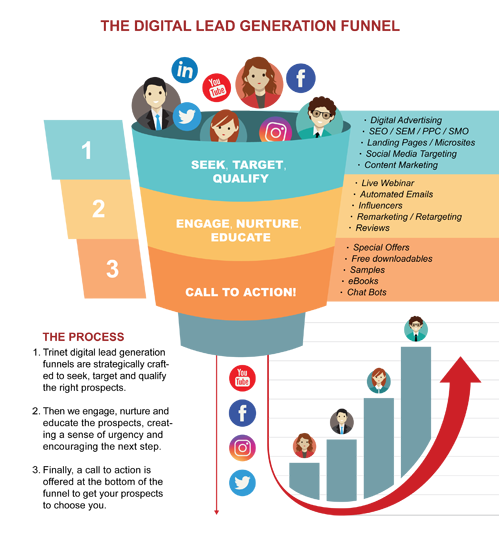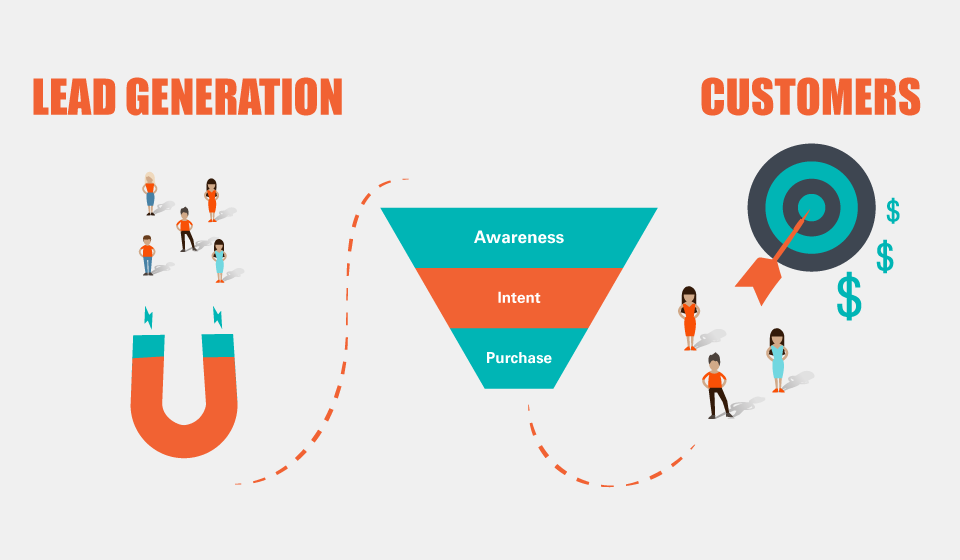Lead generation is vital for any business aiming to grow. It helps attract potential customers.
So, how does lead generation work? In simple terms, lead generation is the process of identifying and attracting individuals who show interest in your product or service. This can be done through various methods such as content marketing, social media, and email campaigns.
The goal is to gather information, like contact details, to nurture these leads into paying customers. Understanding the steps and strategies involved in lead generation can help you boost your business and reach a wider audience. In this blog, we will explore the fundamentals of lead generation, offering clear insights into how it can benefit your business. Keep reading to uncover the secrets of effective lead generation.
Introduction To Lead Generation
Lead generation is a vital part of any marketing strategy. It helps businesses identify and attract potential customers. This process involves various techniques to capture interest in a product or service. By understanding how lead generation works, companies can increase their chances of converting prospects into loyal customers.
Importance Of Lead Generation
Lead generation is crucial for business growth. It helps to create a steady stream of potential customers. These leads can then be nurtured and converted. Without leads, businesses struggle to find new customers. This makes it hard to grow and achieve long-term success.
Generating leads also provides valuable insights. Businesses can learn more about their target audience. This helps to refine marketing strategies and improve products or services. Effective lead generation boosts brand awareness and establishes trust with potential customers.
Lead Generation Vs. Lead Nurturing
Lead generation and lead nurturing are closely related. But they serve different purposes. Lead generation focuses on attracting potential customers. This involves capturing their interest and contact information.
Lead nurturing, on the other hand, involves building relationships. It aims to convert leads into paying customers. This process includes regular communication and providing valuable content. By nurturing leads, businesses can guide them through the sales funnel.
Both lead generation and lead nurturing are essential. Together, they create a comprehensive marketing strategy. This helps businesses attract, engage, and convert potential customers.
Types Of Leads
Understanding the types of leads is crucial for effective lead generation. Leads can be categorized based on their readiness to buy. This helps tailor your approach to nurture them. Let’s explore the three primary types of leads: Cold Leads, Warm Leads, and Hot Leads.
Cold Leads
Cold leads are individuals who have shown little to no interest in your product or service. They have not interacted with your brand yet. They need significant nurturing to become potential customers.
- Limited awareness of your brand.
- Unfamiliar with your offerings.
- Require educational content and engagement.
Cold leads can be nurtured through informative content and targeted outreach. Use social media and email campaigns to build interest.
Warm Leads
Warm leads are individuals who have shown some interest in your offerings. They may have engaged with your content or visited your website. They are aware of your brand and need further engagement to convert.
- Familiar with your brand.
- Have engaged with your content.
- Need nurturing and consistent follow-ups.
Warm leads respond well to personalized content. Use email marketing and retargeting ads to keep them engaged.
Hot Leads
Hot leads are the most promising prospects. They have shown strong interest and are ready to make a purchase. They have interacted with your sales team or completed a demo or trial.
- High level of interest.
- Engaged with sales team.
- Ready to buy.
Hot leads require immediate attention. Provide them with detailed product information and offers to close the deal.
| Type of Lead | Characteristics | Action Required |
|---|---|---|
| Cold Leads | Limited awareness, Unfamiliar, Require education | Informative content, Targeted outreach |
| Warm Leads | Familiar, Engaged, Need follow-ups | Personalized content, Consistent follow-ups |
| Hot Leads | High interest, Engaged with sales, Ready to buy | Immediate attention, Detailed information |
Lead Generation Strategies
Lead generation is a crucial aspect of any business. It involves attracting potential customers and converting them into leads. To achieve this, businesses use various lead generation strategies. These strategies help in identifying and nurturing potential leads. Let’s dive into some effective strategies for generating leads.
Content Marketing
Content marketing involves creating valuable content to attract potential leads. This can include blog posts, videos, infographics, and eBooks. The goal is to provide information that solves a problem for your audience. This builds trust and positions your business as an authority.
- Create high-quality blog posts
- Develop informative videos
- Design engaging infographics
- Offer free eBooks or guides
Email Marketing
Email marketing is a powerful tool for lead generation. It involves sending targeted emails to potential leads. These emails can include newsletters, promotional offers, or updates about your business. The key is to provide value and build a relationship with your audience.
- Build a strong email list
- Segment your audience
- Send personalized emails
- Track email performance
Social Media Marketing
Social media marketing involves using social platforms to attract leads. Platforms like Facebook, Instagram, and LinkedIn are great for connecting with your audience. Share valuable content, engage with followers, and run targeted ads to generate leads.
| Platform | Strategy |
|---|---|
| Share posts, run ads, engage with followers | |
| Post images, stories, and use hashtags | |
| Post articles, connect with professionals |
Seo And Sem
Search Engine Optimization (SEO) and Search Engine Marketing (SEM) are essential for lead generation. SEO involves optimizing your website to rank higher in search results. SEM includes paid advertising to appear in search engine results.
- Conduct keyword research
- Optimize website content
- Run Google Ads campaigns
- Track and analyze performance
Tools For Lead Generation
Lead generation is crucial for business growth. Various tools help in gathering and managing leads effectively. Here, we explore some essential tools for lead generation.
Crm Systems
Customer Relationship Management (CRM) systems are essential for managing customer interactions. They help in organizing and tracking leads throughout the sales funnel. Popular CRM systems include:
- Salesforce
- HubSpot
- Zoho CRM
These systems offer features like contact management, email tracking, and sales forecasting. They provide detailed insights into customer behavior. A good CRM can improve customer satisfaction and sales efficiency.
Lead Capture Forms
Lead capture forms are used on websites to collect visitor information. They are simple and effective tools for generating leads. Key elements of a lead capture form include:
- Name field
- Email field
- Phone number field
- Message or comments section
Effective forms should be easy to fill out. They should also be placed strategically on your website. Forms can be integrated with CRM systems for seamless lead management.
Analytics Tools
Analytics tools help in measuring the performance of lead generation efforts. They provide insights into user behavior and campaign effectiveness. Common analytics tools include:
- Google Analytics
- Mixpanel
- Hotjar
These tools track metrics like website traffic, conversion rates, and user interactions. They help in identifying areas for improvement. Using analytics tools can optimize your lead generation strategy.
Lead Scoring Techniques
Lead scoring is a crucial part of lead generation. It helps businesses identify potential customers who are most likely to convert. By using lead scoring techniques, companies can prioritize their efforts on high-quality leads. This saves time and resources. Let’s dive into two popular lead scoring techniques: behavioral scoring and demographic scoring.
Behavioral Scoring
Behavioral scoring involves tracking a lead’s actions and interactions with your business. These actions give insights into their level of interest and readiness to buy.
- Website Visits: Frequency and pages visited.
- Email Engagement: Opens and clicks.
- Content Downloads: E-books or whitepapers.
- Social Media Interaction: Likes, shares, and comments.
- Webinar Attendance: Participation in online events.
By assigning points to these actions, you can score leads based on their engagement level. Higher scores indicate stronger interest. This helps sales teams focus on leads ready for conversion.
Demographic Scoring
Demographic scoring assesses leads based on their personal and professional information. This includes data such as age, job title, and company size.
| Demographic Data | Score |
|---|---|
| Job Title | High for decision-makers |
| Company Size | High for larger companies |
| Location | High for target regions |
| Industry | High for relevant sectors |
Combining both behavioral and demographic scoring gives a complete view of a lead’s potential. This ensures that marketing and sales teams work together efficiently to convert leads into customers.

Credit: blog.hubspot.com
Nurturing Leads
Nurturing leads is a crucial part of the lead generation process. It involves building relationships with potential customers. This phase helps transform interested individuals into loyal clients. Let’s explore some effective strategies for nurturing leads.
Personalized Email Campaigns
Personalized email campaigns can significantly improve engagement rates. By tailoring emails to individual preferences, businesses can create a more personal connection. This makes recipients feel valued and increases the likelihood of conversion.
Personalized emails should address the recipient by name. Include content that matches their interests and previous interactions. This approach can make communications feel more relevant and engaging.
Retargeting Ads
Retargeting ads can help recapture the interest of potential leads. These ads target individuals who have previously visited your website. They remind users of your products or services and encourage them to return.
Retargeting ads are effective because they reach users already familiar with your brand. This familiarity increases the chance of conversion. It’s like giving a gentle nudge to those who are on the fence about purchasing.
Engaging Content
Engaging content is key to nurturing leads. This includes blog posts, videos, infographics, and social media updates. High-quality content can educate and inform potential customers, building trust over time.
Create content that addresses common questions or problems your audience faces. Offer solutions and insights that add value. This can help position your business as a trusted authority in your industry.
Measuring Lead Generation Success
Understanding the success of your lead generation efforts is crucial. To improve and refine strategies, you need to measure the right metrics. This section will cover the key performance indicators, conversion rates, and ROI analysis.
Key Performance Indicators
Key Performance Indicators (KPIs) are essential for tracking the success of your lead generation. They help you understand what works and what doesn’t. Here are some important KPIs:
- Number of Leads: Track the total number of leads generated.
- Lead Quality: Measure the quality and relevance of your leads.
- Cost per Lead: Calculate the cost associated with acquiring each lead.
- Lead Source: Identify which channels are generating the most leads.
Conversion Rates
Conversion rates show how many leads turn into paying customers. Monitoring these rates helps you understand the effectiveness of your lead nurturing strategies. Key metrics to track include:
- Lead-to-Customer Rate: Percentage of leads that become customers.
- Landing Page Conversion Rate: Percentage of visitors who fill out your form.
- Email Open and Click-Through Rates: Engagement metrics for your email campaigns.
Roi Analysis
Return on Investment (ROI) analysis helps you understand the financial impact of your lead generation campaigns. To calculate ROI, consider the following:
| Metric | Description |
|---|---|
| Total Revenue | Revenue generated from the leads. |
| Total Cost | All costs related to the lead generation efforts. |
| ROI Formula | (Total Revenue – Total Cost) / Total Cost |
By keeping track of these metrics, you can adjust your strategies to maximize your lead generation success.
Common Challenges In Lead Generation
Lead generation can be tough. Businesses face many challenges. These challenges can make it hard to get new customers. This section will talk about some common challenges in lead generation. Understanding these can help improve your efforts.
Generating Quality Leads
One major challenge is generating quality leads. Not all leads are the same. Some leads may not be interested in your product. This can waste time and resources. To get quality leads, you need to know your audience well. Use data to understand their needs and preferences. This helps in targeting the right people.
Maintaining Engagement
Keeping leads engaged is another challenge. Leads need regular interaction to stay interested. Many businesses struggle with this. You need to keep your content fresh and relevant. Use different types of content like blogs, videos, and emails. This keeps the audience engaged and interested in your product.
Aligning Sales And Marketing
Sales and marketing teams often work separately. This can cause issues in lead generation. When these teams are not aligned, leads can fall through the cracks. Both teams should work together. They need to share information and goals. This ensures a smooth process from lead generation to closing a sale.
Future Trends In Lead Generation
Future trends in lead generation are evolving rapidly. These trends will shape how businesses attract and convert leads. Artificial Intelligence, automation, and data privacy are key areas to watch.
Artificial Intelligence
Artificial Intelligence (AI) is a significant trend in lead generation. AI can analyze large datasets quickly. This helps in identifying potential leads more efficiently. AI algorithms can predict customer behavior. This allows businesses to tailor their marketing strategies. AI-driven chatbots can engage with visitors in real-time. They answer queries and collect data, improving the user experience.
Automation
Automation streamlines the lead generation process. Automated tools handle repetitive tasks, saving time and resources. These tools can send personalized emails based on customer behavior. They also track and analyze interactions. This helps in nurturing leads more effectively. Automation ensures consistent follow-ups, reducing the risk of losing potential leads.
Data Privacy
Data privacy is a growing concern in lead generation. New regulations are emerging to protect user data. Businesses must comply with these regulations. This includes obtaining consent before collecting data. Transparency about data usage is crucial. Ensuring data security builds trust with potential leads. It also reduces the risk of legal issues.

Credit: www.freelancer.com

Credit: www.leadfuze.com
Frequently Asked Questions
What Is Lead Generation?
Lead generation is the process of attracting potential customers. It involves strategies to convert interest into sales leads.
Why Is Lead Generation Important?
Lead generation is crucial for business growth. It helps in identifying and targeting potential customers effectively.
How Do You Generate Leads?
You generate leads through various marketing strategies. These include content marketing, social media, SEO, and email campaigns.
What Are The Best Lead Generation Tools?
The best tools include HubSpot, Salesforce, and Mailchimp. These platforms offer comprehensive features for capturing and nurturing leads.
Conclusion
Lead generation is vital for business growth. It connects you with potential clients. Effective strategies attract and convert leads. Focus on quality over quantity. Use tools and technology wisely. Track and measure your success. Adjust tactics as needed. Stay persistent and patient.
Results take time. Keep learning and improving your approach. Success in lead generation means more business opportunities. Make the most of it.



Leave a Reply